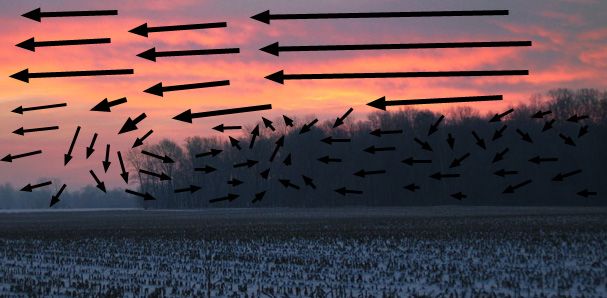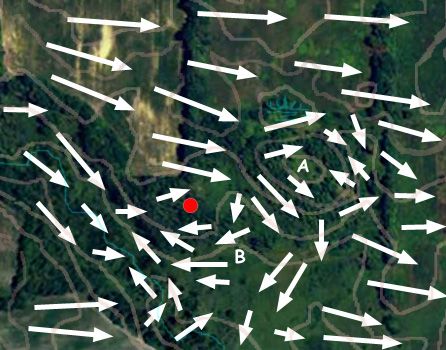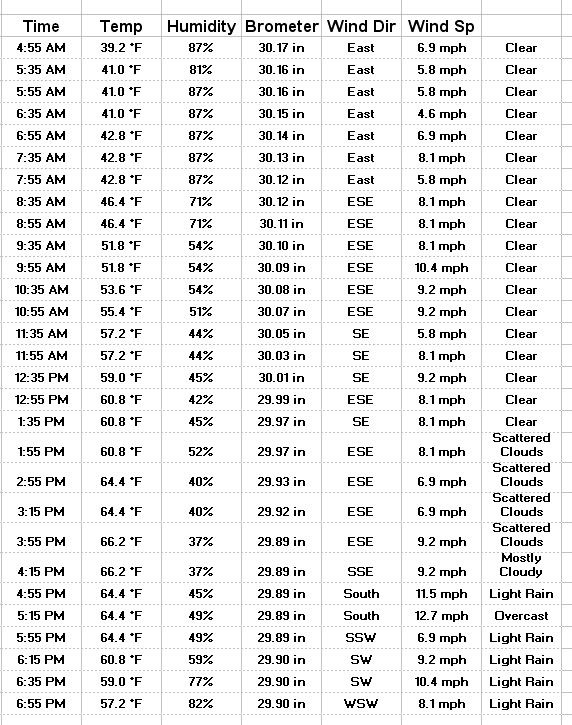Some thoughts on wind.
Setting up stands for the prevailing wind depends on where you hunt.
For example, here in Michigan, the prevailing wind is from the west, but if you look at 30 years of data from Lansing Michigan as shown in the the following figure, an unexpected conclusion can be reached. You can get one of these for your area at
LINK
This image is called a Wind Rose. Each petal coming off it tells you the direction the wind was coming from, and the length tells you the percentage of time it came from that direction. This one happens to be from November. If you break this up into 4 quadrants, and look at the percentage of the time the wind came from each quadrant, you end up with westerly 35%, Northerly 15%, Easterly 12%, and Southerly, 32% (calm about 5%). The wind rose looks a little lopsided but that is just because the longer arms get wider, if you actually measure, you get these numbers.

So what is the definition of prevailing winds? It is the general direction that the wind comes from more often than any other. In Michigan, in November, the winds are "prevailing" about 35% of the time from Oct through Dec. But they are blowing from some other direction 65% of the time. If you set up your property mainly for prevailing winds, you will be wrong most of the time.
Not only that, but it is well known that deer move more in cold weather (northerly winds) and when low pressure is approaching (easterly winds where I live -- weather almost always come from the west, but winds can come from any direction depending on the pressure created by the weather). About 27% of the time the winds are coming from the north or east. Rather than setting up for prevailing winds, it is probably more wise to be sure you are set up for all winds, but most especially for those winds, like north winds, that are likely to bring conditions that will increase deer movement.
Another thing about winds is that most hunters listen to the weather and think that the wind in their hunting area is going to be blowing in the direction that the weatherman
says it is blowing above the trees. Never mind that wind is greatly affected by what is on the ground. For example, the downwind end of a thick woods will almost invariably have a reverse wind . You can test this yourself by just walking along the downwind side and you will feel the wind drawing back into the woods. The reason is that as the wind rushes across the top of the trees it swirls into a kind of low pressure zone created by the blocking trees, much like how a draft works on a race car. You end up with something like this.

Each hunting spot will have its own characterisitcs of shaping the wind. I have one spot where, in October, if there is a brisk west wind to my north, there will be a brisk east wind to my south. Here is a wind map I have drawn from observations of autumn leaves. There is about a 30 foot elevation drop from A to B, plus I am in the lee of the woods, combined, the hill behind me and the lee of the woods create a reversal of direction.

One more example of the futility of playing the winds (in many locations) is that the wind is a fickle thing. Let a cloud go over and the wind may reverse for a while. As the sun rises, there is often a wind that may be reverse to what the main wind for the day is expected to be. These things all conspire towards making "playing the wind" alone a pretty futile plan for many of us. Here is a chart of just one day of hunting, during which I felt wind coming from every direction, but the nearby weather station in Hillsdale was not quite as bad (they took hourly reading) but illustrates my point.
On this day, Nov 13 2010, we hit the stand an hour before daylight and stayed until after dark. Notice at 5 a.m. the temperature was in the high 30s to low 40s, wind was from the east. By midday the wind was from the SE, and by evening it was from the SW. The temperature rose 24 degrees during the day, which of course changes the thermals, and The humidity fell from 87% to 37% during the day. Humidity greatly impacts the diffusion of scent molecules and how they are sensed.

I am not saying in any of this that it is not super important to consider what the wind is doing that day, but am saying that it is critically important to realize it is not always going to be blowing the way you think and it might be doing mysterious things based on the structure of the hunting area and other affects like cloud cover, humidity, etc. through the day.
These and many other observations lead me to the conclusion that the wind is a pretty fickle thing to depend on. Our main defense against this is scent control, followed by scent control, followed by scent control, in that order
